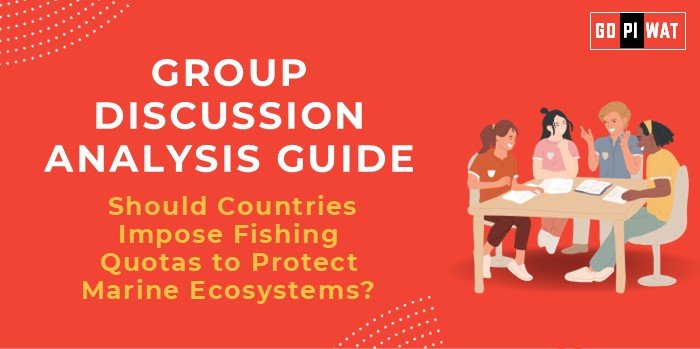📋 Group Discussion (GD) Analysis Guide: Should Countries Impose Fishing Quotas to Protect Marine Ecosystems?
🌐 Introduction to Fishing Quotas and Marine Conservation
- Opening Context: Overfishing has emerged as a global threat, with approximately 34% of the world’s fish stocks overexploited, jeopardizing marine biodiversity and livelihoods. This makes the topic highly relevant for B-school discussions centered on sustainability and policy innovation.
- Topic Background: Fishing quotas are regulatory limits on the amount of fish that can be harvested within a specific period, aimed at preventing overfishing and ensuring sustainable practices. They were first widely implemented in Iceland in the 1980s and are now adopted in various forms by countries like New Zealand and the EU.
📊 Quick Facts and Key Statistics
- 🌍 Overfished Stocks: 34% of global fish stocks are overexploited (FAO, 2022).
- 💰 Economic Dependency: 10-12% of the world’s population relies on fisheries for income.
- 🚫 Illegal Fishing Losses: Estimated $26 billion annually (OECD).
- 🎣 Quotas in Action: EU fishing quotas have reduced overfishing by 30% since 2010.
🤝 Stakeholders and Their Roles
- Governments: Enact and enforce quotas, oversee environmental and economic impacts.
- Fishing Communities: Balance economic needs with sustainable practices.
- International Bodies: e.g., FAO, monitor global practices and foster cooperation.
- Environmental NGOs: Advocate for marine conservation and conduct impact assessments.
🏆 Achievements and Challenges
✨ Achievements
- 🌱 Sustainability: New Zealand’s quota system led to sustainable stock recovery in over 90% of fisheries.
- 💹 Economic Benefits: Iceland’s quota system increased fisheries’ economic value by 20%.
- 🌊 Ecosystem Health: EU quotas reduced discards by 40% since 2013.
⚠️ Challenges
- 🛠️ Enforcement Issues: Developing nations often lack monitoring resources.
- 💸 Economic Strain: Short-term income loss for small-scale fishers.
- 🚨 Illegal Fishing: Loopholes and weak governance undermine regulations.
Global Comparisons:
- ✅ Successful Example: Iceland’s Individual Transferable Quotas (ITQs).
- ⚠️ Challenges in Africa: Overfishing exacerbated by lack of robust governance frameworks.
Case Studies:
- 🇦🇺 Australia: Quotas led to increased biodiversity in the Great Barrier Reef region.
- 🇮🇳 India: Struggles with implementing quotas due to socio-economic complexities.
📖 Structured Arguments for Discussion
- ✅ Supporting Stance: “Fishing quotas have successfully revived depleted stocks and promoted sustainable livelihoods, as seen in Iceland.”
- ⚡ Opposing Stance: “Quotas disproportionately affect small-scale fishers, creating economic inequities and enforcement challenges.”
- ⚖️ Balanced Perspective: “While quotas are effective, they require strong governance and inclusivity to address socio-economic disparities.”
💡 Effective Discussion Approaches
📣 Opening Approaches
- 📊 Highlighting the ecological urgency of overfishing statistics.
- 🌍 Quoting successful case studies like Iceland or New Zealand.
🛡️ Counter-Argument Handling
- 🌟 Recognize challenges but emphasize scalable solutions such as community-managed quotas and technology-driven monitoring.
🛠️ Strategic Analysis of Strengths and Weaknesses
- Strengths: Prevents overfishing, supports long-term sustainability.
- Weaknesses: Enforcement costs, small-scale fisher resistance.
- Opportunities: Leverage AI for monitoring, foster public-private partnerships.
- Threats: Illegal fishing, climate-induced stock migration.
🔗 Connecting with B-School Applications
- Real-World Applications: Policy creation, stakeholder management, sustainability integration.
- Sample Interview Questions:
- “How can fishing quotas be balanced to ensure equity and sustainability?”
- “What role does technology play in sustainable fishing practices?”
- Insights for Students:
- Understand policy frameworks.
- Explore tech-enabled governance solutions.
- Evaluate economic and ecological trade-offs.


